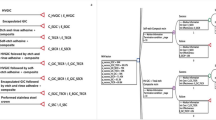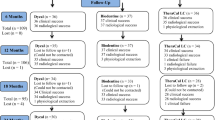Abstract
This study intended to evaluate the effects of inorganic trace elements such as magnesium (Mg), strontium (Sr), and zinc (Zn) on root canal dentin using an Artificial Neural Network (ANN). The authors obtained three hundred extracted human premolars from type II diabetic individuals and divided them into three groups according to the solutions used (Mg, Sr, or Zn). The authors subdivided the specimens for each experimental group into five subgroups according to the duration for which the authors soaked the teeth in the solution: 0 (control group), 1, 2, 5, and 10 min (n = 20). The authors then tested the specimens for root fracture resistance (RFR), surface microhardness (SμH), and tubular density (TD). The authors used the data obtained from half of the specimens in each subgroup (10 specimens) for the training of ANN. The authors then used the trained ANN to evaluate the remaining data. The authors analyzed the data by Kolmogorov–Smirnov, one-way ANOVA, post hoc Tukey, and linear regression analysis (P < 0.05). Treatment with Mg, Sr, and Zn significantly increased the values of RFR and SμH (P < 0.05), and decreased the values of TD in dentin specimens (P < 0.05). The authors did not notice any significant differences between evaluations by manual or ANN methods (P > 0.05). The authors concluded that Mg, Sr, and Zn may improve the RFR and SμH, and decrease the TD of root canal dentin in diabetic individuals. ANN may be used as a reliable method to evaluate the physical properties of dentin.



Similar content being viewed by others
References
Collins H, Calvo S, Greenberg K, Forman Neall L, Morrison S. Information needs in the precision medicine era: how genetics home reference can help. Interact J Med Res. 2016;5(2): e13. https://doi.org/10.2196/ijmr.5199.
National Diabetes Statistics Report. 2020. Centers for disease control and prevention. U.S. Dept of Health and Human Services
Saghiri MA, Karamifar K, Fakharzadeh A, Conte M, Morgano SM. Effect of diabetes on tubular density and push-out bond strength of mineral trioxide aggregate to dentin. J Endod. 2020;46(11):1584–91. https://doi.org/10.1016/j.joen.2020.07.025.
Saghiri MA, Nath D, Rahmani B, Amini S, Karamifar K, Peters OA. The effect of diabetes on fracture resistance of teeth: an in vitro study. Aust Endod J. 2021. https://doi.org/10.1111/aej.12512.
Maciejewska K, Drzazga Z, Kaszuba M. Role of trace elements (Zn, Sr, Fe) in bone development: energy dispersive X-ray fluorescence study of rat bone and tooth tissue. BioFactors. 2014;40(4):425–35. https://doi.org/10.1002/biof.1163.
Saghiri MA, Vakhnovetsky J, Vakhnovetsky A, Ghobrial M, Nath D, Morgano SM. Functional role of inorganic trace elements in dentin apatite Tissue—Part 1: Mg, Sr, Zn, and Fe. J Trace Elem in Med Biol. 2022. https://doi.org/10.1016/j.jtemb.2022.126932.
Kumagai A, Fujita Y, Endo S, Itai K. Concentrations of trace element in human dentin by sex and age. Forensic Sci Int. 2012;219(1–3):29–32. https://doi.org/10.1016/j.forsciint.2011.11.012.
Chieruzzi M, Pagano S, Moretti S, Pinna R, Milia E, Torre L, Eramo S. Nanomaterials for tissue engineering in dentistry. Nanomaterials. 2016;6(7):134. https://doi.org/10.3390/nano6070134.
Qu T, Jing J, Jiang Y, Taylor RJ, Feng JQ, Geiger B, Liu X. Magnesium-containing nanostructured hybrid scaffolds for enhanced dentin regeneration. Tissue Eng Part A. 2014;20(17–18):2422–33. https://doi.org/10.1089/ten.TEA.2013.0741.
Toledano M, Osorio R, Vallecillo-Rivas M, Osorio E, Lynch CD, Aguilera FS, Toledano R, Sauro S. Zn-doping of silicate and hydroxyapatite-based cements: Dentin mechanobiology and bioactivity. J Mech Behav Biomed Mater. 2020. https://doi.org/10.1016/j.jmbbm.2020.104232.
Nguyen TT, Larrivée N, Lee A, Bilaniuk O, Durand R. Use of artificial intelligence in dentistry: current clinical trends and research advances. J Can Dent Assoc. 2021;87(l7):1488–2159.
Daponte P, Grimaldi D. Artificial neural networks in measurements. Measurements. 1998;23:93. https://doi.org/10.1016/s0263-2241(98)00013-x.
Mahmood H, Shaban M, Indave BI, Santos-Silva AR, Rajpoot N, Khurram SA. Use of artificial intelligence in diagnosis of head and neck precancerous and cancerous lesions: a systematic review. Oral Oncol. 2020;110: 104885. https://doi.org/10.1016/j.oraloncology.2020.104885.
Sosimi AA, Gbenebor OP, Oyerinde OS, Bakare OO, Adeosun SO, Olaleye SA. Analysing wear behaviour of Al–CaCO3 composites using ANN and Sugeno-type fuzzy inference systems. Neural Comput Appl. 2020;32(17):13453–64.
Sadighpour L, Rezaei SMM, Paknejad M, Jafary F, Aslani P. The application of an artificial neural network to support decision making in edentulous maxillary implant prostheses. J Res Prac Dent. 2014; i1–10.
Javed S, Zakirulla M, Baig RU, Asif SM, Meer AB. Development of artificial neural network model for prediction of post-streptococcus mutans in dental caries. Comput Methods Programs Biomed. 2020;186: 105198.
Uzunoglu-Özyürek E, Küçükkaya Eren S, Eraslan O, Belli S. Critical evaluation of fracture strength testing for endodontically treated teeth: a finite element analysis study. Restor Dent Endod. 2019;44(2): e15. https://doi.org/10.5395/rde.2019.44.e15.
Shahdad SA, McCabe JF, Bull S, Rusby S, Wassell RW. Hardness measured with traditional Vickers and Martens hardness methods. Dent Mater. 2007;23(9):1079–85. https://doi.org/10.1016/j.dental.2006.10.001.
Larose DT. Discovering knowledge in data. New York: John Wiley & Sons; 2005. p. 105–20.
Negnevitsky M. Artificial Intelligence. CA, USA: Addison-Wesley; 2005. p. 185–9.
Roiger RJ. Data mining: a tutorial-based primer. Chapman and Hall/CRC. 2017. https://doi.org/10.1201/9781315382586.
Imran M, Alsuhaibani SA. Chapter 7 - A neuro-fuzzy inference model for diabetic retinopathy classification. In: Hemanth DJ, Gupta D, Emilia BV, editors. Intell Data Anal Biomed Appl. New York: Academic Press; 2019. p. 147- 172. https://doi.org/10.1016/B978-0-12-815553-0.00007-0.
Mao W, Wang FY. Chapter 8 - Cultural modeling for behavior analysis and prediction. In: Mao W, Wang F-Y, editors. New advances in intelligence and security informatics. New York: Academic Press; 2012. p. 91- 102. https://doi.org/10.1016/B978-0-12-397200-2.00008-7.
Sairamya NJ, Susmitha L, Thomas George S, Subathra MSP. Chapter 12 - Hybrid approach for classification of electroencephalographic signals using time–frequency images with wavelets and texture features. In: Hemanth DJ, Gupta D, Emilia Balas V, editors. Intell Data Anal Biomed Appl. New York: Academic Press; 2019. p. 253- 273. https://doi.org/10.1016/B978-0-12-815553-0.00013-6.
Larose DT. Data mining and predictive analytics. New York: John Wiley & Sons; 2015.
Barajas-Gamboa JS, Tarquino PF, Pedraza JE, Gonzalez-Nuñez D. Reaching a personalized medicine era: the dream of the drug market. Br J of Med Pract. 2016;9(3):5–7.
Genco RJ, Genco FD. Common risk factors in the management of periodontal and associated systemic diseases the dental setting and interprofessional collaboration. J Evid Based Dent Pract. 2014;14:4–16. https://doi.org/10.1016/j.jebdp.2014.03.003.
Cabanillas-Balsera D, Martín-González J, Montero-Miralles P, Sánchez-Domínguez B, Jiménez-Sánchez MC, Segura-Egea JJ. Association between diabetes and nonretention of root filled teeth: a systematic review and meta-analysis. Int Endod J. 2019;52(3):297–306. https://doi.org/10.1111/iej.13011.
Abbassy M, Watari I, Bakry A, Hamba H, Hassan AH, Tagami J, Ono T. Diabetes detrimental effects on enamel and dentine formation. J Dent. 2015;43(5):589–96.
Saghiri MA, Sheibani N, Kawai T, Nath D, Dadvand S, Amini S, Vakhnovetsky J, Morgano SM. Diabetes negatively affects tooth enamel and dentine microhardness: an in-vivo study. Arch Oral Biol. 2022. https://doi.org/10.1016/j.archoralbio.2022.105434.
Saeki K, Marshall GW, Gansky SA, Parkinson CR, Marshall SJ. Strontium effects on root dentin tubule occlusion and nanomechanical properties. Dent Mater. 2016;32(2):240–51.
Bakhit A, Kawashima N, Hashimoto K, Noda S, Nara K, Kuramoto M, Tazawa K, Okiji T. Strontium ranelate promotes odonto-/osteogenic differentiation/mineralization of dental papillae cells in vitro and mineralized tissue formation of the dental pulp in vivo. Sci Rep. 2018;8(1):1–10.
Eimar H, Ghadimi E, Marelli B, Vali H, Nazhat SN, Amin WM, Torres J, Ciobanu O, Junior RFA, Tamimi F. Regulation of enamel hardness by its crystallographic dimensions. Acta Biomater. 2012;8(9):3400–10. https://doi.org/10.1016/j.actbio.2012.06.002.
Ghadimi E, Eimar H, Marelli B, Nazhat SN, Asgharian M, Vali H, Tamimi F. Trace elements can influence the physical properties of tooth enamel. Springerplus. 2013;2(1):1–12. https://doi.org/10.1186/2193-1801-2-499.
Kong Y, Hu X, Zhong Y, Xu K, Wu B, Zheng J. Magnesium-enriched microenvironment promotes odontogenic differentiation in human dental pulp stem cells by activating ERK/BMP2/Smads signaling. Stem Cell Res Ther. 2019;10(1):1–11.
Osorio R, Osorio E, Cabello I, Toledano M. Zinc induces apatite and scholzite formation during dentin remineralization. Caries Res. 2014;48(4):276–90.
Ressler A, Žužić A, Ivanišević I, Kamboj N, Ivanković H. Ionic substituted hydroxyapatite for bone regeneration applications: a review. Open Ceramics. 2021;6: 100122.
Bigi A, Boanini E, Gazzano M. Ion substitution in biological and synthetic apatites. Biominer Biomater. 2016; 235–266.
Bang LT, Long BD, Othman R. Carbonate hydroxyapatite and silicon-substituted carbonate hydroxyapatite: synthesis, mechanical properties, and solubility evaluations. Sci World J. 2014. https://doi.org/10.1155/2014/969876.
Umer F, Habib S. Critical analysis of artificial intelligence in endodontics: a scoping review. J Endod. 2022;48(2):152–60.
Premaratne P. Human computer interaction using hand gestures. Berlin: Springer Science & Business Media; 2014.
Ram Talib NS, Halmi MIE, Abd Ghani SS, Zaidan UH, Shukor MYA. Artificial Neural Networks (ANNs) and Response Surface Methodology (RSM) approach for modelling the optimization of chromium(VI) reduction by newly isolated Acinetobacter radioresistens strain NS-MIE from agricultural soil. Biomed Res Int. 2019;2019:5785387. https://doi.org/10.1155/2019/5785387.
Saghiri MA, Asgar K, Boukani KK, Lotfi M, Aghili H, Delvarani A, Karamifar K, Saghiri AM, Mehrvarzfar P, Garcia-Godoy F. A new approach for locating the minor apical foramen using an artificial neural network. Int Endod J. 2012;45(3):257–65. https://doi.org/10.1111/j.1365-2591.2011.01970.x.
Jung S-K, Kim T-W. New approach for the diagnosis of extractions with neural network machine learning. Am J Orthod Dentofac Orthop. 2016;149(1):127–33.
Durmuş HK, Özkaya E, Meriç C. The use of neural networks for the prediction of wear loss and surface roughness of AA 6351 aluminium alloy. Mater Design. 2006;27(2):156–9. https://doi.org/10.1016/j.matdes.2004.09.011.
Saghiri MA, Saghiri AM. In memoriam: Dr. Hajar Afsar Lajevardi MD, MSc, MS (1955–2015). Iran J of Pediatr. 2017;27(1):1.
Acknowledgements
MAS is a recipient of the New Jersey Health Foundation, TechAdvance, and DenburTech Awards. This publication is dedicated to the memory of Dr. H. Afsar Lajevardi [46], a legendary Pediatrician (1953–2015). The authors will never forget Dr. H Afsar Lajevardi's kindness and support. The views expressed in this paper are those of the authors and do not necessarily reflect the views or policies of the affiliated organizations. The authors hereby announce that they had active cooperation in this scientific study and preparation of the present article. The authors confirm that they have no financial involvement with any commercial company or organization with direct financial interest regarding the materials used in this study. Special thanks to Anna Vakhnovetsky for proofreading and Dr. Fatereh Samadi for interpreting the results in this research. The authors deny any conflicts of interest related to this study.
Author information
Authors and Affiliations
Corresponding author
Ethics declarations
Conflict of interest
None.
Additional information
Publisher's Note
Springer Nature remains neutral with regard to jurisdictional claims in published maps and institutional affiliations.
Rights and permissions
About this article
Cite this article
Saghiri, M.A., Saghiri, A.M., Samadi, E. et al. Neural network approach to evaluate the physical properties of dentin. Odontology 111, 68–77 (2023). https://doi.org/10.1007/s10266-022-00726-4
Received:
Accepted:
Published:
Issue Date:
DOI: https://doi.org/10.1007/s10266-022-00726-4




